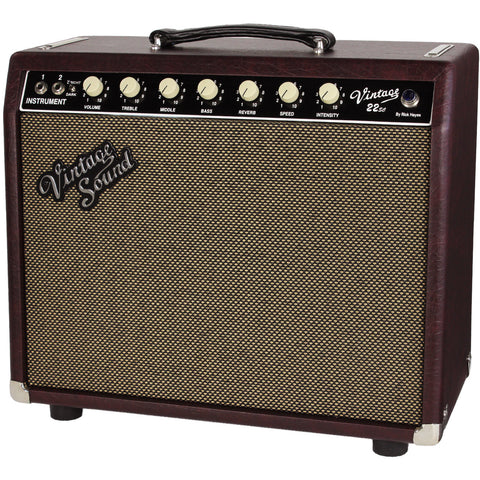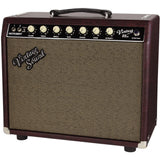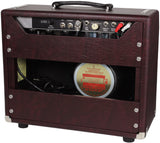The Vintage Sound Vintage 22sc is the amp Leo should have built!
For years guitar players praised the coveted Black Face AB763 circuitry found in the mid 60's Deluxe Reverbs as the Holy Grail of tone. However... We often hear the following from many of them:
1) Why 2 channels? I only use the Vibrato/Reverb channel.
2) Wouldn't it be nice if someone offered a smaller "grab and go" version?
Vintage Sound listened and created the Vintage 22sc ("sc" stands for Single Channel) to be offered exclusively here at Humbucker Music!
This is a true Black Face AB763 based single channel amp housed in a Princeton Reverb size cab, built with a 12" speaker, and the same Black Face circuitry found in a Black Face Deluxe Reverb style amp, only without the unused Normal channel. A Mid range tone pot is added for better tone control, as well as a Dwell control on the back for the Reverb, and a Bright/Dark Switch, so the amp would not be permanently wired in the Bright mode like the original.
To top it off, Vintage Sound also included all the desired improvements people have made to the Deluxe Reverb circuit over the years!
What are these improvements?
1) A "MIDDLE" tone control. This was not on the original Deluxe Reverb, but in adding it absolutely does nothing to hurt the integrity of the original circuit or tone. The original Fender circuit actually had a fixed "MIDDLE" that was set permanently at 6.8k. Vintage Sound removed this resistor from the circuit and replaced it with a versatile 10k pot. The result is you now have the ability to adjust this frequency range without compromising the original tone. If you want it to sound precisely like a 65 Deluxe Reverb, just turn the pot to around 6-7 and you're there. If you want to scoop the mids a touch, pull back. Warm the tone a bit, turn up.
2) The original circuit was somewhat bright. People used to pull the chassis and clip the bright cap allowing a darker tone from their amp. Others, on the other hand, liked it bright. We've eliminated the hassle by including a "bright cap defeat" switch. Flip it to Bright for the original tone, or flip it to dark to essentially "clip" the bright cap.
3) Also included is a very useful reverb dwell control on the rear of the chassis. It comes in quite handy for adjusting the amount of decay the reverb has. Very nice!
4) Another smart alteration is the incorporation of a Diaz based tremolo mod and a newly designed oscillator unique to Vintage Sound Amps. This accomplishes a few things... You'll notice the Vibrato has the ability to be slower than stock Fenders. The vibrato being too fast was always a complaint people had with vintage Fender Deluxe amps (and still do to this day). The other advantage this gives is when you turn the dial all the way down, you switch off the vibrato circuit, bypassing it and leaving you with a cleaner, more pure signal. The result is a slightly more present tone, and a bit of a bump in volume. Furthermore, with the older Deluxe Reverbs, you can hear a "ticking" sound with the vibrato. This is caused by several design flaws in the original circuit allowing the LFO signal to leak into the audio path. These issues have been addressed with a Vintage Sound specifically designed photo-cell tremolo, better routing of the wires, superior components, and filtering of the oscillator output.
5) External Bias Points have been added.
So, what do you end up with?
A truly amazing sounding Deluxe Reverb channel that's truly more toneful than an original with nothing modified in a way that disrupts the original tone.
Specifications:
Wattage: 22 watts
Preamp Tubes: 3 x 12AX7, 2 X 12AT7
Power Tubes: 2 x 6V6 (optional 2x6L6)
Rectifier: 1 x 5AR4
Front Controls: Bright/Dark Switch, Volume, Treble, Middle, Bass, Reverb, Speed, Intensity
Rear Controls: Dwell (Very cool custom feature for controlling the reverb decay time!)
Effects: Tube Driven Spring Reverb, Tube Vibrato
Speaker: 12" WGS G12C/S
Inputs: 2 Inputs
Auxiliary Input: RCA Footswitch Jack
Extension Speaker Jack: External Speaker Jack
Circuit Construction: All Point-to-Point, Hand-wired
Cabinet Construction: Dove-tail jointed solid pine w/Baltic Birch Plywood baffle and back panels
Pilot Light: Blue Amp Jewel
External Bias Points!
Combo Dimensions: 17" High x 19 7/8" Wide x 9 1/2" Deep
Optional Accessories: Two Button Footswitch, Padded Cover
Weight: 37 lbs
Specifications:
Wattage:
22 watts
Preamp Tubes:
4 x 12AX7, 2 X
12AT7
Power Tubes: 2 x 6V6 (optional 2x6L6)
Rectifier:
1 x
5AR4
Front Controls: Bright/Dark Switch, Volume, Treble, Middle, Bass,
Reverb, Speed, Intensity
Rear
Controls:
Dwell (Very cool custom feature for controlling the reverb decay time!)
Effects:
Tube
Driven Spring Reverb, Tube Vibrato
Speaker:
12" WGS G12C/S
Inputs:
2 Inputs
Auxiliary Input: RCA Footswitch Jack
Extension Speaker Jack: External Speaker Jack
Circuit
Construction: All Point-to-Point, Hand-wired
Cabinet Construction: Dove-tail jointed solid pine w/Baltic Birch
Plywood baffle and back panels
Dimensions: 16"
High x 19 7/8" Wide x 9 1/2" Deep
Optional Accessories: Two Button Footswitch, Padded Cover
Weight: 37 lbs
About
the Bias Points:
All Vintage Sound 22sc amps now come with Bias
Points! The advantage of having this option
is you have the ability to easily rebais the amp each time you swap
power tubes. Normally, you'd have to pull the chassis and do it
manually, or take it to a amp shop and have it done at shop labor
rates. With Bias Points you'll be able to do it
yourself with only a simple multi-meter. It's actually VERY easy to do.
Under the VIDEOS tab above you'll find a video that walks you through
biasing your Vintage Sound amp using the bias points.
About
The
WGS G12C/S
We chose the WGS G12C/S for several
reasons. The G12C/S is essentially their take on the Jensen C12n, but
with several refinements, such as a smoother top end, more touch
sensitivity, and an overall warmer tone. A Black Face circuit can be
somewhat sharp and trebly, particularly when distorted. The G12C/S
addresses this very well with it's more rounded top end which is very
noticeable on bright guitars like a Telecaster, etc. Furthermore,
Warehouse Guitar Speakers are made here in the USA and not in China
like most of today's Celestions. Added bonus!
This speaker works great with lower wattage amps in allowing a bit more
clean headroom. When driven harder, the breakup you'll get with the
Vintage Sound 22sc will be all tube saturated overdrive and not
distortion from the speaker. This speaker is based on the popular G12C,
but with a smooth cone, felt dust cap, and just the right amount of
edge treatment.
 Vintage Sound Vintage 22sc
Vintage Sound Vintage 22sc
Vintage Sound Amplifiers make some of our favorite Blackface voiced amps around. They incorporate circuits and voicings that we're all so familiar with yet reaching past the overly simple features that may have held some guitarists back from Blackface amps over the years. We all enjoy vintage tone, but why can't we have our tone and enjoy new ideas too? Leo Fender was big on listening to what players had to say about what they needed or used, and what they didn't. This is precisely what Vintage Sound Amps has done! By listening to decades of guitarists, they have figured out exactly what us vintage tone hounds were after: the Vintage Sound 22sc. Stylistic and aesthetic qualities stay true to the vintage vibe of an old Fender amp, but don't let that fool you into thinking that it's the same 'ol thing! Immediately noticeable differences with the 22sc are the addition of a 'Mid' knob, as well as a Reverb Dwell Control that together offer many new textures to the Deluxe Reverb circuit. Other internal modifications exist within the 22sc which we'll go over in more detail below.
The AB763 circuit from the 22 watt 60's Fender Deluxe Reverb is the cream of the tonal crop for some of us out there with its rich tone, ease of transport and reliable history. For decades, guitarists have often commented on their lack of use of the Normal channel on a Deluxe. As many of us know, you can remove the first preamp tube associated with the Normal channel leaving you with a hotter signal and a little more gain. By turning the Tremolo Intensity knob to zero, you actively remove it from the circuit as well, again resulting in an even hotter signal. So with the circuit being a hand wired point to point board with the capabilities of a shorter signal path, and in a Princeton sized cab, this amp, may be one of the best grab and go amps around!
Is it loud enough?
The Vintage 22sc has enough volume to carry you from practice to the club. On top of that, the bass response of the VS amps are unparalleled for an amp of this small of a stature. Think of this amp as a Deluxe style amp in a Princeton sized cab. With the pine cab and the 12" speaker, you'll want to turn the amp upside down to see if someone snuck a pair of 6L6 power tubes into it!
Features
As mentioned above, this amp features a "Mid" knob not found in the typical Deluxe Reverb circuit. This was achieved by removing the the 6.8k fixed bias resistor from the AB763 and replacing it with a 10k pot, allowing players to refine their tone further than before. If you want it to be perfectly period correct, no problem! Just move the mid knob to about 6 or 7 and it will give you 6.8k of resistance. Voila!
The reverb on this amp, like all good blackface amps, has a wonderful spacial feel. With the 22sc, Vintage Sound has added a versatile Dwell control on the back allowing you to control the reverb decay. This is a feature many of us verb lovers have always wished was on our old Fender amps. You typically found this only on the Fender dedicated reverb units, so we're quite pleased to have it on Vintage Sound amps.
As if these two modifications weren't enough, the 22SC features a Bright Cap Defeat Switch to tame some of the top end associated with this style of amp or give it that high end sparkle to guide your guitar to the front of a mix. As well, the Tremolo circuit on the VS 22sc is the much loved Diaz based Modded Tremolo circuit with a newly designed oscillator specific to Vintage Sound which allows a slower speed and less noise than the original Fender design. When you turn the Tremolo Intensity dial all of the way to zero, the Mod also completely eliminates the Tremolo circuit from the signal path. So even if you don't find yourself using it often, you don't have to worry about it dragging down your precious tone!
After trying many speaker combinations, Humbucker Music and Vintage Sound has opted to use the WGS C/S12 for it's ability to tame some of the top end most notably associated with the Deluxes and Princetons while helping accentuate the 22sc's solid lows. We feel this speaker is absolutely a solid choice for this amp.
Construction
All Vintage Sound Amps utilize pine cabinets and are constructed with dove tailed joints to ensure years of solid use as well as the stronger joints that allow the cab to resonate more freely than many other construction methods. A Baltic Birch floating baffle allows the front baffle to 'breathe a bit more', when in conjunction with the light resonant softer pine, you end up with a cab that imparts its own frequency to your sound. This cab resonance may be more important to help you find that sound in your head than you may initially think!
Overall
Overall, I find the Vintage Sound 22sc to be an extremely satisfying amp that is surely to find great success through its ability to be carried around with ease, while pumping out Blackface tones reminiscent of amps past (not the reissues)! So, if you're in the market for vintage Blackface tone, look no further than the Vintage Sound 22Ssc. Do you loose anything over a two channel Deluxe style amp? In my opinion, no. I have perhaps in my 25+ years of playing, encountered only a handful of players who utilized both the Normal and the Vibrato channels on their amp during a particular gig.
Effects pedals have made such an influence on the tones that we're now so familiar with, that even using the Normal Channel as a different EQ setting is irrelivant these days. Think about it... A half-pound pedal versus all of the additional weight of a second amp channel, not to mention the additional signal path and internal resistance that you now avoid. I don't think that you loose anything at all. If anything, you gain. You gain a shorter signal path, a bypassable Tremolo circuit, a stronger, resonant, more vibrant cab and the ability to tote around a hand wired point to point amp that weighs in at under 40lbs! This is definitely one of the best grab and go amps on the market today and a sure fit for stages and studios alike.
- Jeremy Walley, Humbucker Music












